Transporting your bike on a bike rack help free up lots of space and is easier. There are many types of bike racks, and this may bring more confusion when shopping. Roof racks allow quick access to the rear trunk. The trunk racks are lightweight and are more affordable; they also fit a wide variety of vehicles. Those who use the hitch rack load and unload bikes much easier.
Why do you need a bike rack? This is a big decision, and one must make serious considerations before arriving at the right model and type. A bike rack makes it easy and safe to carry multiple bikes. They help protect the bike from scratching or causing damage to your luggage. Here are some selected bike racks for your choosing.
1. Swagman XC Cross-Country 2-Bike Hitch Mount Rack
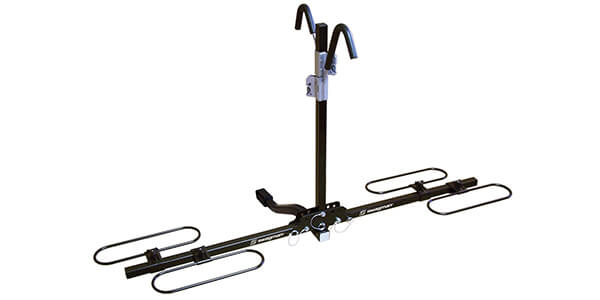
Experience a stress-free way to carry your bike while traveling. It secures each wheel and the frame for a more stable and safe ride. It has cushioned hooks that can adjust to fit any bike size for a tight fit. It can transport up to two bikes and has a built-in anti-wobble hitch device. The upright ratchet arms adjust for whatever bike size you may have. The frame grip arms are soft to protect the bike’s finish. When you want to access the rear of the vehicle, the center arms will fold down, so you do not have to remove the rack.
2. Allen Sports Deluxe 5-Bike Hitch Mount Rack with 2-Inch Receive
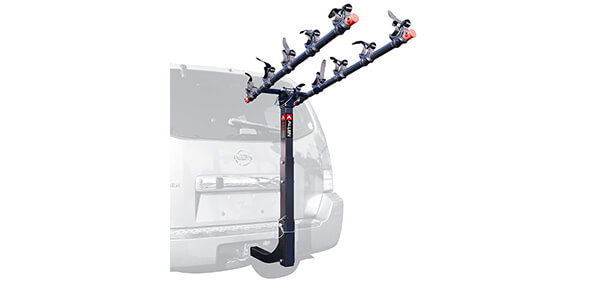
This bike rack can carry up to five bikes and installs on most standard 2-inch class 3 and four receiver hitches. This rack is easy to assemble and has folding carry arms for when they are not in use. It also features a tilt-away main mast for lift-gate access and tie-down cradle. It only requires three bolts to assemble, quickly install and get on the road within minutes. It is backed by Allen’s lifetime warranty assuring you of quality and durability. The no-wobble hitch installation ensures a smooth ride.
3. Thule T2 Pro XT 2 Bike Rack
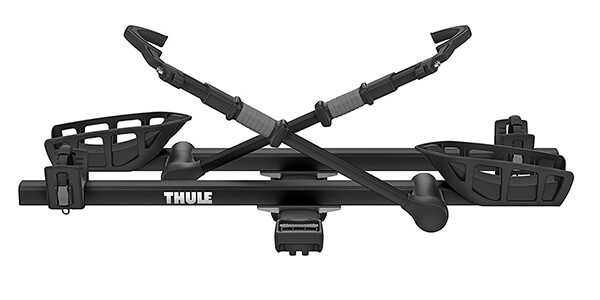
The Thule T2 is what you need to securely and conveniently carry your bike during transport. Install it quickly without using any tool. The built-in lock cylinder completes the installation securely. The hitch switch lever tilts the rack up and down to allow easy access to the functionality. When you are not using the rack, just fold it into a compact piece or storage. Its ratcheting arm secures the bike and does not make any frame contact. Its integrated 24-inch cable secures the bike to the rack and conveniently retracts when not in use.
4. Yakima Products RidgeBack Hitch Bike Rack
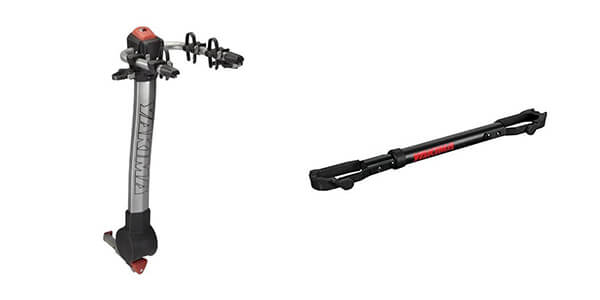
The Yakima hitch bike rack is a product you must get for transporting bikes from home to your camping or biking trails. It features a tool-free locking SpeedKnob to allow quick installation and securely locks the rack to the vehicle. The ZipStips secures the bike to the rack and can be removed. The anti-sway cradle eliminates bike-to-bike contact even on uneven roads. The rack will fit a 1.25-inch and 2-inch hitch receiver and is strong enough to carry two bikes.
5. Saris Bones 2-Bike Trunk Rack
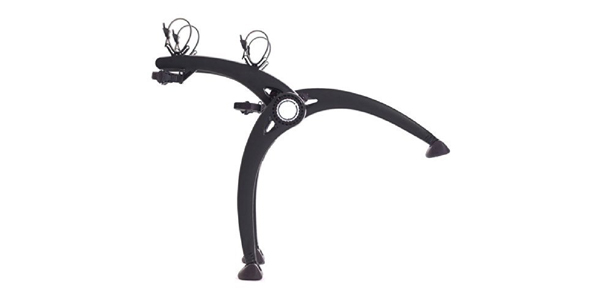
This rack is a tested statement of design, style, durability, and convenience. It is both good looking and built to make bike transportation easier. It carries up to two bikes and fits sedans, minivans, hatchbacks, SUVs and almost all cars fitted with rear spoilers. It has rubberized feet to protect the vehicle coating and straps for protecting the bike. It has the strongest frame you will find on the market and weighs only 9 lbs. It is made of injected-molded arms and legs and is fully rust-free for durability. It separates bikes on different levels and has anti-sway straps to secure each bike. The vinyl-coated hooks are designed to work without damaging the vehicle’s finish.
6. Saris Bones 801 3-Bike Trunk Mount Rack
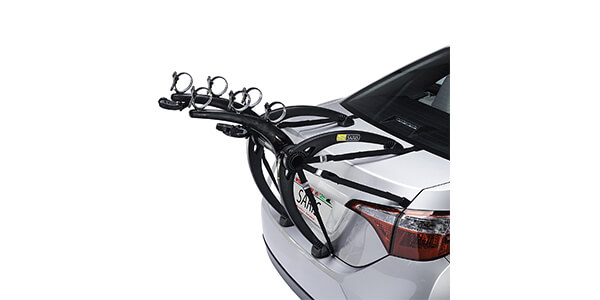
Match your personality with this excellent bike rack. It has plenty of colors to choose from that you will not fail to get what goes with your car. Carry up to three bikes in this durable and secure carrier. The spring buckles straps have vinyl-coated hooks to protect your vehicle’s finish. Its strong frame gives you peace of mind knowing your bike will be safe until the end of the journey. The articulated rubber feet will protect the car’s paint while the anti-sway straps securely hold the bike, therefore, protecting them from one another. At just 11 lbs, it is easy to carry on and off while dismounting for storage.
7. Yakima FullTilt 4 Bike Rack
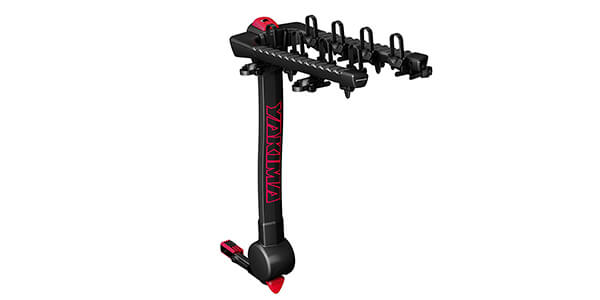
This bike rack from Yakima comes fully assembled and features an integrated security system to lock the bike to the rack while also locking the rack to the vehicle for total security. The AutoPin conveniently positions and secures the rack into the receiver automatically. It uses the tool-free SpeedKnob to tighten and lock the rack to the car quickly. The UpperHand lever efficiently tilts the rack to allow easy access and folds the rack flat for storage. The ZipStrips secures the bike to the rack while the anti-sway cradles eliminate bike-to-bike contact. Enjoy the lifetime warranty that assures you of quality and performance rill you leave it.
8. Swagman 64683 Bicycle Carriers Chinook 2 Carrier Platform Hitch Rack
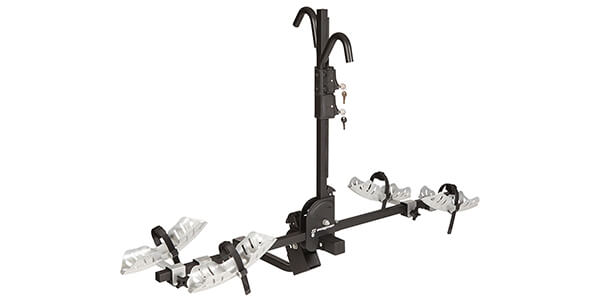
Work with a convenient and durable bike rack that will only make your life easier. It brings reliability and ease of use molded into one product. It weighs just 35 pounds and is easy to install. It features a tilt-down function that allows rear access to the vehicle even when the bikes are loaded. Carry up to two bikes on this rack and securely lock the two bikes with same key lock cylinders that hook the ratchet down onto the bike frame. When not in use, the Chinook folds up against the vehicle.
9. Direct Aftermarket Steel Motorcycle Scooter Dirt Bike Rack
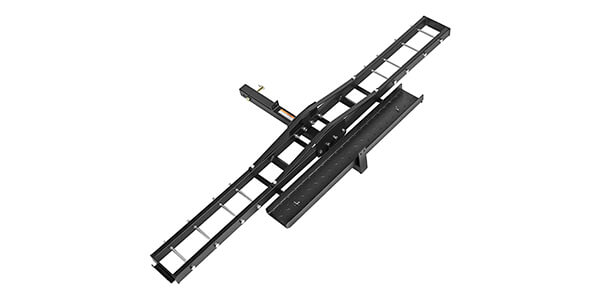
Get great hauling capacity for your bikes, scooters and any other item. It is constructed with weather-resistant epoxy powder-coated tubular steel. This makes it rust resistant and strong enough to carry large loads of up to 500 pounds. You can load bikes from either side of the rack adding to the convenience. It measures 76 inches wide and 33 inches long, large enough to carry large items.
10. Road-Max RMBR4 Hitch Mount Tray Style 4 Bike Carrier
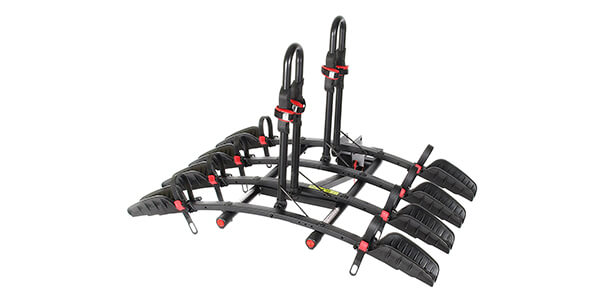
The Road-Max hitch mount bike rack has a compact and lightweight design for easy use and storage. The arm can fold when you are not using the rack so it can fit the car trunk very easily. The adjustable padded arm supports the bike vertically while the strong locking attachment system can easily fit any 2-inch receiver. The high resistance wheel straps featuring Zamack buckles and soft pads will fit the rims of any tire size.
Types of Bike Racks
Roof Mounted Bike Rack
This type consists of a metal rack installed on the vehicle roof to hold bicycles upright. They are better since they keep the bicycle out if the line of sight when driving. The rack can even be left on top of the vehicle when not in use making them a great long-term option. However, if you are traveling in an area with low clearance, roof racks become a hindrance. Low bridges, parking garages, or low hanging trees will make it difficult to drive. These types of racks should never be used with heavyweight bikes. They also carry a risk of damage to the bike from debris, animals, insects or the weather while traveling.
Hitch mount bike rack
This is another common bike rack. It uses the vehicle’s hitch to suspend the bike from the tail end of the car. There are many styles of hitch mount including hanging platform designs most of which have a simple loading and unloading mechanism.
This type helps avoid the low clearance risks that affect the roof rack. They are more aerodynamic to make your drive smoother.
A hanging hitch mount weighs and costs less than the platform design. They may also require additional devices to prevent the bike from swaying as you drive along. You may require an adaptor for bikes with typical frames. Some models can suspend the bikes just from the wheels whereas others need to make contact with the frames.
The hitch mount style is great for carrying multiple bicycles though they can be a bit expensive. Some designs may be difficult to mount and remove from the vehicle. Before choosing a hitch mount rack, consider the type of bike, how many you want to carry, your car design, and whether you will experience restrictions on the tailgate access.
Platform Bike Rack
This type is heavier and costlier but provides many benefits than the other designs. Its stable design eliminates the swaying problem during transport and can carry many different bike styles. It makes minimal contact with the bike ensuring the bike is protected, therefore lowering the risk of frame damage.
Trunk Mount Bike Rack
This is the most popular style of the bike rack. It is a convenient option and can carry multiple bikes and be stored when not in use. This type does not require additional assembly and avoids the hazards associated with roof racks. They are lightweight and very user-friendly compared to the rest. They easily attached to the spare tire or trunk door. When purchasing this bike rack, consider your vehicle design. An option that is not well suited to your car will cause deforming, dents, or scratches.
Considerations
Even though most bike racks are easy to attach to the vehicle, there are a few considerations to makes before choosing a model:
– Roof racks require the most effort to mount and unmounts the bikes and will require extensive lifting.
– Most bike racks include easy installation process. However, the style chosen should not limit your visibility and car accessibility from features you may need.
– Since the trunk mount is easy to install and remove, this makes it easy to steal together with your bike.
– A platform bike is the best for you if you do not want or cannot lift the bike very high.
Factors to consider
Fold Away Racks
This is a hitch rack with an additional feature that allows the rack to fold down to allow access to the trunk. Once the bike has been unloaded, the rack can be lowered out of your way to allow the trunk to be opened. This is crucial for the van or SUVs with hatchbacks that cannot open if something is in the way. It is difficult lowering the bike to access the trunk and raising the back on multiple times on a trip. To avoid this, consider a rack with a swing away design.
Swing Away Racks
These types are more expensive than the standard types or fold away designs. They, however, allow easy access to the trunk when needed. They have a rotating joint on the rack arm. You just need to remove a pin or loosen a knob to allow the arm to open up and swing to the right or left of the vehicle. You will then gain full access to the trunk while the bikes are off to the side. They do not require lowering or raising the bikes.
Bike Carrying Capability
Before settling on a bike rack, consider its carrying capacity. Rack types vary in their abilities, but hitch rack is the best for families with many bikes. Consider the number of bikes you need to carry and possibly an additional slot for future needs or to carry a friend’s bike.
Anti-Rattle Devices
To protect your bike, choose a rack with an anti-rattle device. The trailer hitches can emit aloud rattling noise when in use. With an anti-rattle accessory installed, there is a significant noise reduction during motion. You can use a weight slid between the rack and the hitch to eliminate space or use a sleeve clamp to tighten the space the shank meets the rack to eliminate room for bouncing.
Ease of Assembly
A bike rack should be as easy to assemble as possible to eliminate the hassle or force you to get a professional. This is a task you will want to complete once. Some racks leave users frustrated and confused, even with an instruction manual.
Vehicle Fit Resources
The best rack should have fit guides to help you match your vehicle and bike to the rack. This will eliminate any stress of modifying the rack to accept the vehicle or bike or even the long process or returning the rack post-purchase.
Frame Compatibility
With the rate at which racks are hitting the market, it is not easy getting bicycle frame compatibility information. Using the bike frame as the main attachment point is likely to lead to compatibility issues. Some types, however, are designed to accommodate moats bike types.
Security
Before purchasing a bike rack, kindly consider the rack and bike security. Some types offer excellent security features while others have none. Some racks have locks to prevent bike theft but will cost more. If you plan to leave your bike unattended on your vehicle, then a rack with excellent security features is crucial. Failing to consider this will leave you with no bike or even the entire rack will be stolen.
Conclusion
From this guide, you will find that the market has a variety of bike racks to suit every vehicle. Choose the best type and size for your vehicle and bike carrying needs. The most important factors to consider are the mounting type, bike carrying capacity, security, and bike protection from damage. Going in blind is a recipe for disaster, but if you are armed with this guide full of information, you will have a clear mind to choose the best rack for your needs.